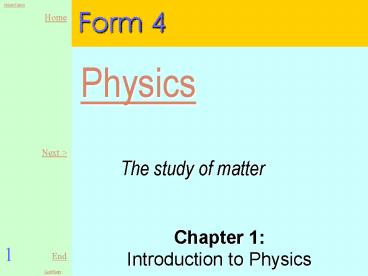Chapter 1: Introduction to Physics - PowerPoint PPT Presentation
1 / 15
Title:
Chapter 1: Introduction to Physics
Description:
... Measuring Instruments Sensitivity = how small a change in reading that can be measured by an instrument Ruler Low, 1 mm Vernier caliper Medium, ... – PowerPoint PPT presentation
Number of Views:832
Avg rating:3.0/5.0
Title: Chapter 1: Introduction to Physics
1
Chapter 1 Introduction to Physics
Form 4
Physics
Next gt
The study of matter
1
2
Objectives (what you will learn)
1) understand Physics2) base quantities
derived quantities3) scalar quantities vector
quantities4) measurements, using
instruments5) processes in scientific
investigations
Physics Chapter 1
2
3
Understanding Physics
Physics
1. Physics derives from Latin, physica - the
science of natural things until 19th century, it
was called natural philosophy. Through its
subfield of astronomy, it may be the oldest
academic discipline.
2. Physics is a branch of Science for study of
natural phenomena, which involves force, matter
energy based on experimental observations
quantitative measurements.
3
4
Base Quantities
Physical Quantities
Quantities that cannot be defined in any other
physical quantity.
Base Quantity Symbol SI Unit Symbol
Length l meter m
Mass m kilogram kg
Time t second s
Temperature T Kelvin K
Current I Ampere A
4
5
Derived Quantities
Physical Quantities
Quantities derived from base quantities (through
mathematical combinations).Volume Length x
Breath x Height m3Density Mass Volume
kg m-3Velocity Displacement Time m s-1
Acceleration Velocity Time m s-2Force
Mass x Acceleration kg m s-2
5
6
Physical Quantities
Scalar Quantity
Physical quantity which has magnitude only, such
as distance and mass.(Compare them to base
quantities.)
Vector Quantity
Physical quantity which has both magnitude and
direction, such as force and pressure.(Compare
them to derived quantities.)
6
7
Physical Quantities
Prefixes
Simplifies description of physical quantities
that are either very big or very small without
losing data.
prefix symbol value
pico p 10-12
nana n 10-9
micro µ 10-6
milli m 10-3
centi c 10-2
prefix symbol value
kilo k 103
mega M 106
giga G 109
tera T 1012
7
8
Physical Quantities
Scientific Notation
The standard form for numerical magnitude.
Q x 10nwhere 1 Q lt 10 and n is an integer
Examples0.000000696 m 6.96 x 10-7 m911 000
000 kg 9.11 x 108 kg
8
9
Measurements
Accuracy measures how close a hit is to the
target. If it is too far from the target, it is
not accurate.
Consistency measures how close together a group
of hits is to the average value. If they are far
apart from each other, they are not consistent.
We want results that are both accurate
consistent.
9
10
Measuring Instruments
Sensitivity how small a change in reading that
can be measured by an instrument
10
11
Measurement Errors
Systematic ErrorOccurs in one direction only.
too low
too high
Always negative
Always positive
or
May arise from various causes.
- Incorrect calibration of instruments
- Zero error pointer of instrument does not
return to zero when not in use, such as a ruler
worn out at one end
- Repeated error in reaction time
11
- Wrong assumption
12
Measurement Errors
Random ErrorSize of error not constant
unpredictable.The reading is sometimes positive
sometimes negative from actual value.
12
13
Scientific Investigation
The processes involved
13
14
Scientific Experiment
Steps involved in carrying out Experiment
14
15
Summary
What you have learned
- Understanding Physics
lt Back
- Physical Quantities
3. Measurements Instruments
4. Scientific Investigations Experiments
15
Thank You































